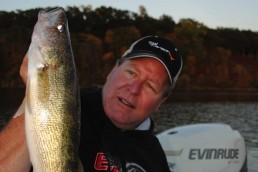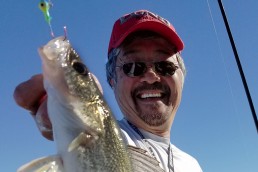River Walleyes and Saugers: Fishing the Fall Bite
SHARE THIS POST
As the weather gets cooler, with frost on the pumpkin, many outdoor folk’s sights are set on the fall hunting season and the upcoming holidays. For the angler, this is a great time of year to target walleyes and saugers in rivers.
In the fall, as the water temperature drops, walleyes and saugers will make a run up the river similar to the spring run. They will look for the deeper holes and will locate near them. They will start dropping deeper into them as the temperature drops. They can even become quite aggressive and feed heavily at times.
Find the holdouts in the holes
Location is the key to fall and winter walleye and sauger fishing. The nice thing is, locating them is not that difficult. The first thing to do is to locate the deep wintering holes. The first step is to get a good contour map of the river or section of the river you are going to be fishing. If you have mapping on your GPS unit, you can locate them that way.
Knowing some river basics can really help. Any time a river makes a bend, you can count on a hole being on the outside of the bend. When flowing water is forced to turn at a bend, the current will dig out a hole.
When you have a narrow area where current passes through, you have an increase in the speed of the current. With the increase in speed, a washout hole will be created.
When you locate a hole, run the length with your electronics. You are searching for a key depth to mark the fish on your graph. Look to see if the fish are located at the head, tail out, along the edges, or in the hole. Often, the upstream fish are the most aggressive. But fish in any of the locations can definitely be caught.
If you find a bunch of active fish in a certain area of the hole, you can start to run a pattern. You can jump from hole to hole fishing the particular area you found them. If you found most of the biters in the tail out of the hole, fish all the tail outs until the pattern changes. This is how you can put a bunch of really nice fish in the boat.
Targeting dams
Some rivers have manmade wing dams. At the deep end of the wing dam, a deep hole is created because of the redirection and speed increase of the current. One of the most popular spots to fish on a river is below a dam. A dam is usually the furthest the fish can go upstream. Below most dams is a washout hole that some fish will spend the fall and winter in.
Hooking the big ones
Another tip on location. If you are just catching small Saugers, move shallower. A lot of times the bigger saugers are shallower than smaller saugers. Usually you will find your walleyes shallower than the saugers. Saugers like more current and sand than walleyes. Walleyes prefer more rock and gravel.
Are you enjoying this post?
You can be among the first to get the latest info on where to go, what to use and how to use it!
Techniques and baits to try
There are several productive ways to catch river walleyes and saugers throughout the fall and winter. The most popular and very productive technique is vertical jigging with the current. Jigs baited with minnows are the most popular. A plain jig or a Lindy Fuzz e Grub is a longtime favorite. You can also use a jig and plastic. Shad tails, curly tails, ring worms and Gulp Minnows are some examples of popular tails. You can use them with or without a minnow.
Make sure you keep your lines vertical while you are moving down current. If it is windy, point your bow into the wind. If you are using a tiller motor, keep the back of the boat into the wind. Make sure you use a heavy enough jig to maintain bottom contact. Sometimes a really heavy jig pounding the bottom will attract fish and produce hard strikes.
A few other baits that really work well vertical jigging are blade baits like Heddon Sonars, Big Dudes, Cicadas, and Zips. Sometimes the vibration of the blade bait will catch fish when they won’t hit a jig and minnow. Jigging Spoons and Jigging Rapalas or Shiver Minnows are also deadly river baits.
Another really deadly presentation is pulling three-way rigs up current. On the dropper, most guys will use a bell sinker like on a Wolf River Rig. A better option is to use a heavy jig like the Bass Pro Shops Current Cutter Jig. Flat-sided river jigs are absolutely deadly. Use jigs from 3/8 ounce all the way up to 1.5 ounces. Rig the jig with a plastic tail and a minnow or just a plain minnow. On the leader line, you can use a plain hook with a bead, a floating jighead, a Spin N Glow, or a small minnowbait like an Original Rapala. Sometimes this presentation will outfish vertical jigging. When you locate fish, vertical jig through them with the current. At the end of the drift, change presentations and pull three ways back through them and see which presentation is best. Sometimes both will work well.
Trolling upriver
Another presentation is trolling crankbaits. Usually upstream trolling is better than downstream trolling. Many different styles of crankbaits will work, depending on where you are fishing and what the forage base is. On most rivers, you can usually get away with trolling flat lines. On rivers connected to the Great Lakes, the fish will come into the rivers suspended in the water column so planer boards can be used. They work really well in clear rivers. You can troll monofilament line like 10-pound Trilene XT or 12-pound Berkley Big Game. They are the same diameter lines that were used while creating the Precision Trolling Dive Curves.
You can also use leadcore line. This line is used when you want to get a smaller crankbait or shallow-diving crankbait deeper. The most popular size lead-core line used by walleye anglers is 18 pound. You can tie in a short leader of monofilament line from the leadcore to a snap. Roughly 5 to 6 feet is all that is needed. In extremely clear water, you can use a fluorocarbon leader. 10- to 12-pound-test leader is all that you need. You can really cover some water to locate and put nice fish in the boat.
Opportunities for prime fishing are everywhere
There are so many excellent rivers to fish throughout the Midwest. The Mississippi River has many great pools with outstanding walleyes and saugers. The Wisconsin, the Illinois, the Missouri, plus the many rivers flowing into the Great Lakes produce trophy walleye fishing. The Detroit, the Fox, the Saginaw, the St. Louis, and the Thames just to name a few. A lot of rivers can be fished throughout the winter months for guys who are not into ice-fishing. It’s a great time to catch a bunch of eaters for the table or a trophy. This fall, plan a trip to a river and experience some awesome sauger and walleye fishing in the “Strike Zone.”
MWO
SHARE THIS POST
Did you enjoy this post?
You can be among the first to get the latest info on where to go, what to use and how to use it!
Phil Piscitello
Phil Piscitello has 45 years of experience as a multispecies angler on ice and open water. He is a fishing guide, master charter captain and seminar speaker guiding in northern Illinois and southern Wisconsin. Picitello is also a regular guest on Chauncey’s Great Outdoors radio show and MidWest Outdoors TV show. He has fished all five Great Lakes and many major rivers, lakes, and reservoirs throughout the Midwest.


